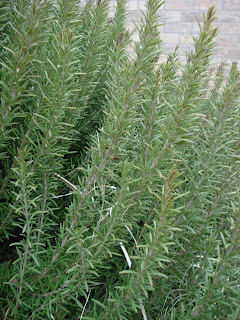Rosemary stays green all winter which provides a welcome burst of green during the cold, brown months. As such, it also provides a burst of fresh flavor in the kitchen! Dice it up for cooking, or snip several longer woody branches from a mature plant to use as flavorful skewers for kabobs.
While tolerant of poor soils, rosemary in not tolerant of over-watering. I don't usually water my front landscape at all in the winter - whatever runs off the front of the house is enough. As you know, we've had a ton of winter preciptation this year, and here you can see the die back that results when rosemary gets wet feet. This is the view when walking out my front door right now - beautiful, isn't it? Between runoff from the roof and a slope in the sidewalk that retains water, this rosemary's not completely happy!
Here's the same bush from the front which doesn't look so bad.
Rosemary gets a slight burgundy winter color at the tips, but it doesn't affect the overall look of the plant much. You'll also notice that the plant gets a slight gray-green color to it in winter and turns a brighter green with warmer weather.
Here's another stand of rosemary about twenty feet away which looks a little better. I planted this about four or five years ago from three quart-size plants I bought at the garden center. You can see that the they've all grown together to form one large planting. That's a crape myrtle in the foreground and Cabaret Miscanthus grass in the back which is really pretty in the summer. (Ornamental grasses can be cut back in the winter if you prefer, but I usually leave mine until they start to flush again in the spring.)































